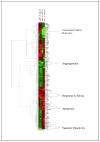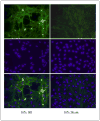Pulmonary endothelial cell activation during experimental acute kidney injury
- PMID: 21368714
- PMCID: PMC3139735
- DOI: 10.1097/SHK.0b013e3182169c76
Pulmonary endothelial cell activation during experimental acute kidney injury
Abstract
Acute kidney injury (AKI) leads to increased lung microvascular permeability, leukocyte infiltration, and upregulation of soluble inflammatory proteins in rodents. Most work investigating connections between AKI and pulmonary dysfunction, however, has focused on characterizing whole lung tissue changes associated with AKI. Studies at the cellular level are essential to understanding the molecular basis of lung changes during AKI. Given that the pulmonary microvascular barrier is functionally abnormal during AKI, we hypothesized that AKI induces a specific proinflammatory and proapoptotic lung endothelial cell (EC) response. Four and 24 h after kidney ischemia/reperfusion injury or bilateral nephrectomy, murine pulmonary ECs were isolated via tissue digestion followed by magnetic bead sorting. Purified lung ECs were analyzed for changes in mRNA expression using real-time SuperArray polymerase chain reaction analysis of genes related to EC function. In parallel experiments, confluent rat pulmonary microvascular ECs were treated with AKI or control serum to evaluate functional cellular alterations. Immunocytochemistry and FACS analysis of Annexin V/propidium iodide staining were used to evaluate cytoskeletal changes and promotion of apoptosis. Isolated murine pulmonary ECs exhibited significant changes in the expression of gene products related to inflammation, vascular reactivity, and programmed cell death. Further experiments using an in vitro rat pulmonary microvascular EC system revealed that AKI serum induced functional cellular changes related to apoptosis, including structural actin alterations and phosphatidylserine translocation. Analysis and segregation of both upregulated and downregulated genes into functional roles suggest that these transcriptional events likely participate in the transition to an activated proinflammatory and proapoptotic EC phenotype during AKI. Further mechanistic analysis of EC-specific events in the lung during AKI might reveal potential novel therapeutic targets for the deleterious kidney-lung crosstalk in the critically ill patient.
Figures






References
-
- Akcan-Arikan A, Zappitelli M, Loftis LL, Washburn KK, Jefferson LS, Goldstein SL. Modified RIFLE criteria in critically ill children with acute kidney injury. Kidney Int. 2007;71:1028–1035. - PubMed
-
- Bailey D, Phan V, Litalien C, Ducruet T, Merouani A, Lacroix J, Gauvin F. Risk factors of acute renal failure in critically ill children: A prospective descriptive epidemiological study. Pediatr Crit Care Med. 2007;8:29–35. - PubMed
-
- Chertow GM, Burdick E, Honour M, Bonventre JV, Bates DW. Acute kidney injury, mortality, length of stay, and costs in hospitalized patients. J Am Soc Nephrol. 2005;16:3365–3370. - PubMed
-
- Deng J, Hu X, Yuen PS, Star RA. Alpha-melanocyte-stimulating hormone inhibits lung injury after renal ischemia/reperfusion. Am J Respir Crit Care Med. 2004;169:749–756. - PubMed
-
- Feltes CM, Van Eyk J, Rabb H. Distant-organ changes after acute kidney injury. Nephron Physiol. 2008;109:p80–84. - PubMed
Publication types
MeSH terms
Substances
Grants and funding
LinkOut - more resources
Full Text Sources

